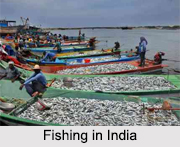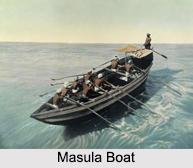 Fishery in India is one of the most significant sectors of food industry. Fortunately, there has been a marked enhancement in fish production ever since Indian Independence from the British rule. India is resourceful enough to bring about development in Indian Fisheries and various agencies have contributed to the growth of Fishery in India. In this regard, it is important to note that India is one of the largest producers of both marine and inland fish.
Fishery in India is one of the most significant sectors of food industry. Fortunately, there has been a marked enhancement in fish production ever since Indian Independence from the British rule. India is resourceful enough to bring about development in Indian Fisheries and various agencies have contributed to the growth of Fishery in India. In this regard, it is important to note that India is one of the largest producers of both marine and inland fish.
Resources Available for the Growth of Fishery in India
India has extensive freshwater resources in the form of rivers and canals (197,024 km), reservoirs (3.15 million ha), ponds and tanks (235 million ha), oxbow lakes and derelict waters (1.3 million ha), brackish water (1.24 million ha) and estuaries (0.29 million ha) to offer to its important sector of fishery. Based in the ecosystem structure and functions, the Indian coastline can be divided into 22 zones.  The Indian fishery industry has a coastline of over 8,000 km and an Exclusive Economic Zone (EEZ) of over 2 million sq kms to exploit. People who catch fish have about 2.4 lakhs fishing crafts active on the coast, about 6 major fishing harbors, about 62 minor fishing harbors and about 1511 landing centers available to them. There are about 3,288 marine fishing villages and about 1,511 marine fish landing centers in 9 maritime states and 2 union territories, according to the CMFRI Census, 2010. This census also recorded about 4 million total marine fisher-folks in about 864,550 families. The fisher-folks have various types of boats available to them for working in India. It ranges from the traditional catamarans, masula boats, plank-built boats, dug out canoes, machwas, dhonis to the present day motorized fibre-glass boats, mechanized trawlers and gillnetters.
The Indian fishery industry has a coastline of over 8,000 km and an Exclusive Economic Zone (EEZ) of over 2 million sq kms to exploit. People who catch fish have about 2.4 lakhs fishing crafts active on the coast, about 6 major fishing harbors, about 62 minor fishing harbors and about 1511 landing centers available to them. There are about 3,288 marine fishing villages and about 1,511 marine fish landing centers in 9 maritime states and 2 union territories, according to the CMFRI Census, 2010. This census also recorded about 4 million total marine fisher-folks in about 864,550 families. The fisher-folks have various types of boats available to them for working in India. It ranges from the traditional catamarans, masula boats, plank-built boats, dug out canoes, machwas, dhonis to the present day motorized fibre-glass boats, mechanized trawlers and gillnetters.
Promotion of Fishery in India
Recently, ornamental fish culture and high value fish farming are gaining importance along with food fish culture. To serve the nation, about 39 Brackishwater Fish Farms Development Agencies or BFDAs and about 429 Fish Development Agencies or FFDAs have sprang up. They promote freshwater and coastal aquaculture.
Significance of Indian fishery
Indian fishery is an essential contributor to the national food basket. The fisheries sector provides employment to over 11 million people. They are engaged fully or partially in fishing and also in subsidiary or ancillary activities in the sector. Indian fishery comprises of about 6.3 percent of the global fish production, 1.1 percent of the GDP (Gross Domestic Product) and 5.15 percent of the agricultural GDP. Fisheries and aquaculture contribute about 1.07 percent to the national GDP and 5.30 percent to agriculture and allied activities. Fish and fish products comprise of a large part of the agricultural exports of India. More specifically, they constitute about 10 percent of the total exports of the country. More than 50 different types of fish and shellfish products are exported to about 75 countries around the world. Thus, it can be said that Indian fishery also helps in foreign exchange earning.
Increase in Fish Production in India
Currently, the total fish production of about 10.07 million metric tonnes has nearly 65 percent contribution from the inland sector and nearly the same from culture fisheries. It had been estimated that the inland capture of fish had increased from 192,000 tonnes in 1950 to 781,846 tonnes in 2007. In this type of catch, cyprinids, siluroids and murrels were the major species extracted. It had also been estimated that India`s marine capture of fish had increased from 520,000 tonnes in 1950 to 3.15 million tonnes in 2007. In this type of catch, oil sardines, penaeid and non-penaeid shrimp, Indian mackerel, croakers and threadfin breams, smaller quantities of cephalopods, etc were extracted.















